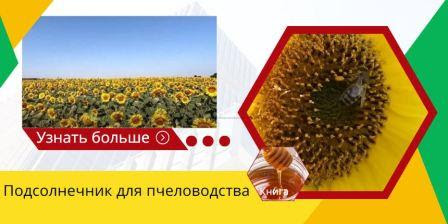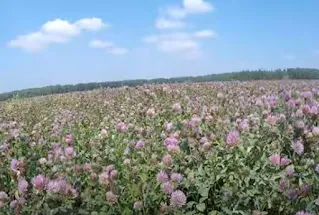Organization of pollination of red clover by honey bees
Who pollinates clover
Clover is an excellent fodder crop, but its distribution is constrained by difficulties in obtaining seeds. To obtain a good crop of seeds, full pollination is necessary. In the case of red clover, bumblebees are excellent pollinators, which should be at least 2000 pieces per 1 hectare. Recently, in nature, such a concentration of bumblebees is no longer observed. Red clover pollinators can be honey bees.
...
.
...
What is the difficulty of pollinating clover by bees
No less important than bumblebees pollinators of red clover are honey bees.
However, the structure of the red clover flower makes the availability of nectar problematic for the bees. The fact is that clover nectaries are located at the base of the corolla, the average length of the flower tube is 9.4-10.5 mm. The average length of the proboscis of a bee is 6.5-7 mm, so the bee cannot completely get this nectar with its proboscis. At one time, this even gave rise to the myth that only long-proboscis bees can pollinate red clover, and therefore, there was a flourishing use of gray and yellow Caucasian bees to pollinate clover in all regions of Russia.
Which bees pollinate clover best
In fact, in the Baltic States and Belarus, karnika copes quite well with the pollination of clover. In Russia, the Central Russian breed of bees copes with this perfectly. Not bad works on red clover and Ukrainian steppe bees and the Carpathian breed of bees, which in Europe is considered a subspecies of Krajina bees. The answer is quite simple, in order to pollinate a red clover flower, you need to transfer pollen from one flower to another, and not collect nectar from red clover.
Of course, in the case when bees cannot get nectar from red clover flowers, and this often happens in years when red clover secretes little nectar, bees are very reluctant to visit this crop, so the beekeeper needs to carry out a number of activities when pollinating clover, which will be discussed said below.
Therefore, no matter what breed of bees you have, any breed of honey bees that is available will be suitable for pollinating red clover.
How many bees does it take to pollinate clover
It is important to maintain the density of bees for full pollination of red clover.
It is believed that for reliable pollination of red clover, 3 hives with strong bee colonies are set per 1 hectare (the strength of the family is at least 4 kg of bees). This standard is derived as follows - with 500 - 600 clover inflorescences per square meter, the optimal frequency of visiting each red clover flower by bees for pollination is 2, which means 70 bees are enough, and for this it is necessary to bring an apiary to sowing at the rate of 3 families per 1 hectare .
Other authors note that on 100 m2 of double-cut clover, depending on the fertility of the soil and the number of inflorescences per square meter, a different number of bees should work. Therefore, it is quite possible to meet the statement in the literature that the standard of 60-100 bees per 100 square meters can be achieved by bringing 1.6 - 2 bee colonies per 1 hectare of crops.
Also, many authors indicate that the standard for bringing bees to clover seed plots can reach 10 bee colonies per 1 hectare. The motivation for such a large number of bee colonies in the seed plots of red clover is explained quite simply. Such saturation with bees makes it possible to pollinate the site very quickly, and to avoid extended seed ripening, which is often important in certain climatic conditions, for example, in the Baltic States, and to avoid seed losses.
Therefore, to calculate how many bees are needed to pollinate red clover, it is necessary to rely on the climatic conditions of the area and the number of clover flowers per square meter.
Measures taken to increase clover attendance by bees
Measures taken by the beekeeper and farmer to increase the attendance of clover by bees.
- Hives are taken out 1-2 days before flowering or at the very beginning of clover flowering.
- Strong, healthy colonies weighing at least 4 kg of bees are used for pollination of clover.
- Bees are placed directly at the crops in groups, at a distance of no more than 500 m from each other. When removing the apiary 600 m from the crops, the collection of seeds decreases by 15-20%.
- Train bees to visit red clover. In the mornings, during the entire flowering period of the testicles, 100 g of sugar syrup infused with clover flowers is placed in each hive. When training for clover, the flight of bees to this crop increases by an average of 5-7 times. To prepare a flavored syrup, you can use not only flowers, but also clover pollen. 10-50 g of clover pollen is added to 1 liter of syrup. It is first stirred in a small amount of syrup, and then mixed with syrup prepared for the entire apiary. The syrup can quickly ferment, so it is prepared before use. In addition to bee training aimed at visiting red clover, bee training is used toyu to visit the bees of certain areas of the field, which are poorly visited by them.
- Use bait crops, which can increase the yield of clover seeds by 25-30% if properly placed.
- They also bring bee colonies with a large amount of brood, the pollination activity of bees increases with an increase in open brood in the nests. The number of open brood in a bee colony is increased either by substituting one or two frames with larvae from other colonies, or by encouraging the queen to lay eggs.
- Reduce bee-bread stocks by removing bee-bread frames from bee nests.
- Hang a pollen trap to collect clover pollen. At the same time, the attendance of red clover increases by 2-3 times.
Conditions for the use of bait plants
Competing melliferous vegetation does not have much effect on visiting clover seed plots under the following conditions
The apiary should be located close to the red clover crops, if the apiary is relatively far away, at least 500 meters from the crops, the bees will prefer competing honey vegetation to clover.
If the period of nectar release in bait plants does not coincide with the period of nectar release in clover.
As bait plants, pink clover, buckwheat, phacelia are best suited.
Lure crops of pink clover in a small field are best sown in a narrow strip, along the elongated side of the seed plot. If the field is large, then bait crops are sown in 1-3 passes of the seeder inside the clover sowing, every 100-200 m.
If pink clover is used as a bait crop, it can be sown together with red clover at the rate of 1.5 kg of seeds per 1 hectare, while reducing the seeding rate of red clover by 20-25%. With separate sowing of a bait crop, its area should not exceed 10% of the area of the seed plot.
An example of using bees to pollinate red clover
An example of the use of red clover pollination by bees.
The yield of clover seeds on the farm does not exceed 0.6 q/ha without pollination of red clover by bees.
When bees are delivered at the beginning of the flowering phase at the rate of 3.2 colonies with a strength of 12 frames with bees per 1 ha using training, against the backdrop of high agricultural technology, if there are favorable weather conditions during the flowering period, the yield of clover seeds from the pollinated array reaches 2.6 centners / ha.
Thus, the effect of renting bees on a red clover seed plot is equal to receiving an additional 200 kg of seeds per hectare.
As you can see, proper pollination of red clover by bees can increase the yield of clover seeds by more than 4 times.


Комментариев нет:
Отправить комментарий